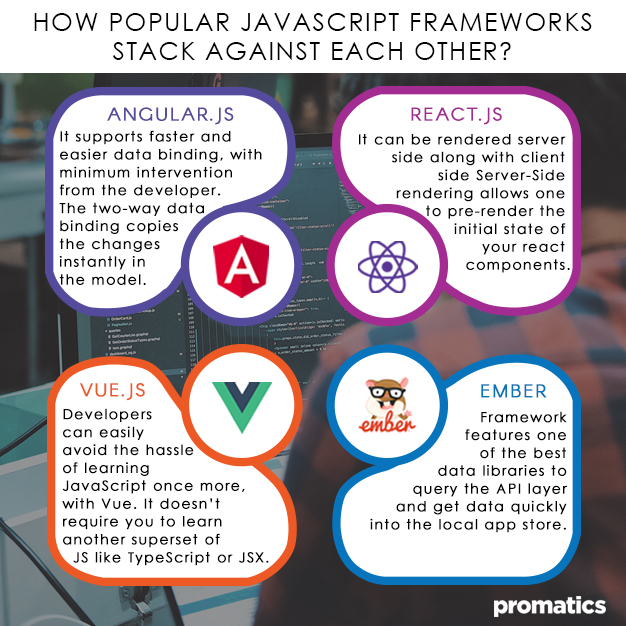Here are the top 4 Javascript frameworks for frontend development
Troubled by the complexities of syntax and value functions in app building, most developers have to write difficult workarounds to solve problems in the language. JavaScript frameworks are a ready-made solution to such problems of the syntax and semantics. App world is flooded with a wide range of JavaScript app frameworks. These frontend JS frameworks ease the pain points of the client-side development process such as routing, managing app state, and communicating with the backend and help developers streamline the whole process.
These frontend JS frameworks pose as a skeleton for single page apps. Here is why you need to choose JS frameworks for front end client-side app development:
1.) Developers can direct their focus on creating complex UI elements instead of getting caught up in code structure or maintenance. It improves the efficiency of the project by using well-structured prebuilt patterns and functions.
2.) JS frameworks are open source and free, mostly. Opting for frameworks reduces overall costs.
3.) Backed by large communities; the JavaScript frameworks provide support and security for app development processes.
Young front end developers often end up confused about the choice of a JavaScript application framework that they need to make, more so in the case of single page applications. Our team at Promatics Technologies works with various JS frameworks for client-side development of our projects. We are familiar with the ecosystems that popular JS frameworks feature. Here, we elucidate on the most popular JavaScript frameworks for Frontend Development:
Most Popular Javascript Frameworks
I. React.js
A UI library developed at Facebook, React helps facilitate the creation of interactive, stateful & reusable UI components. React is the market leader when it comes to JS Frameworks. It uses a reactive approach and a functional programming paradigm. The framework introduced many of its own concepts to craft a unique approach to frontend web development.
React applications are divided into multiple components. Each one of the component files contains both business logic and HTML markup. For an app developer to master React, he/she will need to have in-depth knowledge of component-based architecture, JSX, and unidirectional data flow. To ease communication between components, developers can either choose Flux or a similar JS library. A unidirectional data flow is implemented by Flux.
Pros
1. Comes with a React Create App, a command line interface that allows one to rapidly set up a React project.
2. It can be rendered server side along with client side. Server-Side rendering allows one to pre-render the initial state of your react components.
3. Virtual DOM of React selectively renders subtrees of nodes base on state changes. It is an efficient solution. Minimal DOM manipulation helps keep the components up to date.
4. The unidirectional data flow is also known as one-way data binding. The data flows in a single direction throughout the application, which gives the user better control over it.
5. Features JSX, a special markup language that mixes HTML into JavaScript. It is a XML/ HTML like syntax that extends the ECMAScript so that XML/ HTML like text can co-exist along with JavaScript react code.
6. React allows developers to use the views functions of the state, allowing easy manipulation of the state of the components passed to the ReactJS view.
7. Allows access to Axios and Redux-based libraries, JS libraries that let you organize communication with the backend.
Cons
1. Working with React, a developer is required to build a workflow on his/her own.
2. Other JS frameworks offer plenty of ready tools that are built into them, as compared to React.
3. Choice of many additional libraries land developers in a dilemma of what exactly should they use with React. Thus the development workflow gets deteriorated with React.
4. JSX is complex and has a very steep learning curve
5. As React product created using Redux app grows bigger, applying small changes becomes time-consuming.
Conclusion
React needs to be your first choice for creating an advanced user interface if you are not overwhelmed by plenty of React tools.
II. Angular.js
Google’s Angular combines declarative templates, dependency injection, end to end tooling, and integrates best practices to solve development challenges. It automatically splits the app into components, thus saving the developer development time. Additionally, data models enable a developer to put data manually. Directives are separated from the code and are solved with manual integration. This minimises a long, complicated code beautifully. It uses HTML to form the interface of the app. As there are so many elements present in a function, there is no need to manipulate the DOM in Angular.js.
Pros
1. It supports faster and easier data binding, with minimum intervention from the developer. The two-way data binding copies the changes instantly in the model.
2. The two-way binding approach relieves the developer of actively manipulating DOM (Document Object Model). Thus, the developer saves time and efforts to code while translating and updating the DOM elements.
3. While you could only insert a link to the AngularJS library in the main HTML file previously, now you can install separate modules. This framework flexibility is applaudable.
Cons
1. A long time is taken to render pages of websites and applications designed as long as it performs additional tasks like DOM manipulation. However, this is restricted to old computers and devices.
2. Limited official documentation and steep learning curve of Angular deter new app developers from adopting it.
3. TypeScript makes the Angular 2+ framework difficult to work with.
Conclusion
Angular is a wholesome framework with all the tools for a modern app. Developers must choose Angular if they want to avoid the confusion that comes with choosing from additional libraries as with React.
III. Vue.js
Vue library is just the perfect blend of React and Angular frameworks. To allow components interaction, Vue uses the props and state objects, like React. It also lets developers mix HTML layouts with JavaScript, like Angular. Simple Vue directives like v-bind or v-if can be used to interpolate values from the component logic to templates. Nuxt.js, a project tailored to creating server-side applications with Vue; Nuxt.js is basically a competitor to Angular Universal.
Pros
1. Developers can easily avoid the hassle of learning JavaScript once more, with Vue. It doesn’t require you to learn another superset of JavaScript like TypeScript (for Angular) or JSX (for React).
Cons
1. Vue has far fewer ready solutions, because of its low popularity.
Conclusion
Vue is extremely close in terms of its workflow when compared to other frameworks. Developers opt for Vue because it’s less complicated than React and Angular 2+. However, Angular with its a solid framework and React with its solid choice of libraries far outweigh the simplicity that Vue offers.
IV. Ember
1. One of the oldest JS frameworks on the market, Ember is as up to date as its newer competitors.
2. It strikes a unique balance between scalability, backward compatibility, and experimentation.
3. It allows developers to implement a component-based application. Having said that, we also believe that it is one of the most difficult JavaScript frameworks for frontend web development.
4. It features an intricate architecture comprising of adapters, components, controllers, helpers, models, routes, services, templates, utils, and add-ons, which aid developers in building huge client-side applications. Each and every part of Ember has a narrow focus.
Pros
1. Ember’s features a command line interface tool that enhances productivity by allowing developers to create new projects with ready setups as well as create components, controllers, and other project files from the terminal using automatic generation.
2. It even allows the installation of third-party dependencies.Framework features one of the best data libraries to query the API layer and get data quickly into the local app store.
Cons
1. The framework supports REST API querying but requires the developer to write AJAX requests using jQuery middleware in Ember to fetch data from API that is not bound by REST standards.
2. Constant pairing with jQuery doesn’t fare well with new developers. Most developers prefer using axios or standard fetch for making ajax requests.
3. It has a very steep learning curve
4. The Ember Fastboot is not wholly stable.
Conclusion
Ember is one of the most desirable frameworks to develop complex client-side apps. It is unique because it comes with an inspector plugin or a CLI, which allows a great quick start experience.
How They Stack Against Each Other?
There is a good and bad side of every JS framework. This leaves every frontend developer with a difficult choice about which is the best JS framework. Our team of app developers at Promatics; chooses the framework according to client preference, requirement, and the use-case.
a.) If you are working with a relatively small team, Vue can be your best bet. The final app outcome features a cleaner code, with Vue.
b.) Ember is the best choice for super-advanced client-side apps
c.) React is a preferred choice for developers who require flexible solutions because of the vast range of libraries it offers.
We’ve mentioned only the four most popular web frameworks in this article. Professional developers should keep an open mind when it comes to choosing a JavaScript framework for a work project. There is no absolute best framework, one needs to find the one that suits the needs of the project the best.
Still have your concerns?
Your concerns are legit, and we know how to deal with them. Hook us up for a discussion, no strings attached, and we will show how we can add value to your operations!

